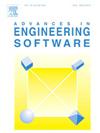Study on the dynamic performance of the vehicle-ballastless track system subjected to dislocation of fault zone
IF 5.7
2区 工程技术
Q2 COMPUTER SCIENCE, INTERDISCIPLINARY APPLICATIONS
引用次数: 0
Abstract
China's High-speed railways are now being constructed on a large scale in the complex mountainous regions of the West. However, due to the large number of active fault zones (AFZs) in western China, track structures inevitably need to be laid in fault zones. To understand the impact of small fault dislocations on the mechanical behavior of vehicle-track interaction in the elastic region, this paper establishes a vehicle-track-soil dynamic model. This model employs a novel iterative algorithm to describe and compute the static deformation of the track induced by the AFZ. Besides, the additional deformation of tracks is treated as the e of the vehicle-track-soil interaction system, for depicting its dynamic effects on the interaction system. The validation and an illustrative case are implemented in numerical studies, which demonstrate the effectiveness of the proposed model. The analysis results indicate that the dynamic performance of the vehicle-track interaction system in the vertical direction deteriorates obviously subjected to the dislocation of fault. The high stiffness of slab tracks exacerbates their vulnerability to fault-induced deformations, particularly for the phenomenon that large localized tensile stress occurs under the moving vehicle load. Moreover, the laying angle of the ballastless track is also a significant factor that degrades the performance of the vehicle-track interaction system subjected to fault dislocation, an aspect overlooked in previous research related to railway foundation deformation.
断裂带错位作用下车辆-无砟轨道系统动态性能研究
中国的高速铁路正在西部复杂的山区大规模建设。然而,由于中国西部地区活动断裂带较多,轨道结构不可避免地需要在断裂带中铺设。为了解弹性区小断层位错对车辆-轨道相互作用力学行为的影响,建立了车辆-轨道-土壤动力学模型。该模型采用一种新颖的迭代算法来描述和计算AFZ引起的轨道静态变形。此外,将轨道附加变形作为车辆-轨道-土壤相互作用系统的e,以描述其对相互作用系统的动力影响。通过数值计算验证了该模型的有效性,并给出了一个算例。分析结果表明,在故障错位的作用下,车轨相互作用系统在垂直方向上的动力性能明显恶化。板状轨道的高刚度加剧了它们对断层诱发变形的脆弱性,特别是在移动车辆荷载下发生较大局部拉应力的现象。此外,无砟轨道的铺设角度也是影响断层错动下车轨相互作用系统性能的重要因素,而这是以往铁路基础变形研究中忽视的一个方面。
本文章由计算机程序翻译,如有差异,请以英文原文为准。
求助全文
约1分钟内获得全文
求助全文
来源期刊

Advances in Engineering Software
工程技术-计算机:跨学科应用
CiteScore
7.70
自引率
4.20%
发文量
169
审稿时长
37 days
期刊介绍:
The objective of this journal is to communicate recent and projected advances in computer-based engineering techniques. The fields covered include mechanical, aerospace, civil and environmental engineering, with an emphasis on research and development leading to practical problem-solving.
The scope of the journal includes:
• Innovative computational strategies and numerical algorithms for large-scale engineering problems
• Analysis and simulation techniques and systems
• Model and mesh generation
• Control of the accuracy, stability and efficiency of computational process
• Exploitation of new computing environments (eg distributed hetergeneous and collaborative computing)
• Advanced visualization techniques, virtual environments and prototyping
• Applications of AI, knowledge-based systems, computational intelligence, including fuzzy logic, neural networks and evolutionary computations
• Application of object-oriented technology to engineering problems
• Intelligent human computer interfaces
• Design automation, multidisciplinary design and optimization
• CAD, CAE and integrated process and product development systems
• Quality and reliability.
 求助内容:
求助内容: 应助结果提醒方式:
应助结果提醒方式:


